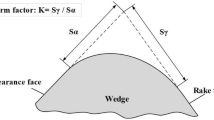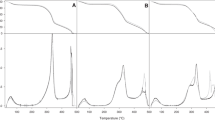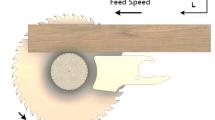Abstract
The processing of wood as a renewable and sustainable material is steadily gaining in importance. However, sawing processes in sawmills are characterized by high electrical energy consumption. Improving the geometry of the saw teeth is an option to make sawing processes more energy efficient and sustainable. Since the industrial sawing processes in sawmills are rather inflexible, the development of new saw tooth geometries takes place in smaller experimental setups. However, the inhomogeneous and anisotropic properties of wood make it difficult to compare different material samples and saw teeth on the basis of measured values. This leads to untapped potentials regarding energy efficiency and sustainability in industrial sawing processes. This paper discusses material properties of spruce wood samples, depending on their place of extraction from the tree trunk. The measured variables considered are the wood moisture content, strength properties and the cutting force occurring during the sawing process. The results show that the measured values vary to different degrees within a tree trunk and between different tree trunks. Based on the results the validity of comparison measurements in the tool development process can be improved and thus increase the efficiency and sustainability of industrial sawing processes.
You have full access to this open access chapter, Download conference paper PDF
Similar content being viewed by others
Keywords
1 Introduction
Wood is becoming increasingly attractive as the most important renewable raw material. Particularly as a raw material, construction material and energy source. Wood can act as an effective carbon store, since it consists of half carbon. This is especially true when it is used in durable products, where carbon remains sequestered harmlessly to the climate. Furthermore, finite and climate-damaging fossil raw materials can be replaced by wood. Less carbon is released than when fossil fuels are used, resulting in a positive CO2 balance [1].
The demand for more environmentally friendly solutions also poses new challenges for wood technology. Rising energy costs and scarce resources must lead to further development of woodworking processes. This also applies in particular to the machining of wood-based materials. Although wood is one of the oldest materials used by mankind, it still presents people with major challenges [2]. Especially when machining wood, a lot of experience and also knowledge about the material behavior is essential. And although individual sub-areas are known, an exact prediction regarding all influencing variables during the machining process is not possible [3]. Problems arise mainly from the fact that wood is a natural material with hygroscopic and anisotropic properties [4]. In addition, there is a high degree of scatter in terms of material behavior and measurable values both within a wood species and within a single trunk. [5]. Each tree has its own history due to its location and the climatic conditions prevailing there, which has an influence on the structure of the tree [6]. New developments and improvements can therefore only be realized through deeper knowledge of wood as a material and the fundamentals of processing methods [2].
One way to improve the process is to optimize the cutting tool. In this way, target parameters of the cutting process such as cutting force, wear and energy consumption can be positively influenced. In order to obtain meaningful testing results for newly developed tools, the scatter of material properties on the samples must be kept as low as possible. The results of this paper help to better assess the influence of the location of wood sampling from the trunk. Thus, the results from comparative tests can be interpreted more accurately in the context of saw tooth development.
2 State of the Art
Wood is a complex and flexible material. It consists of numerous substances that are organized in different ways, resulting in an irregular structure. This allows its use for various product areas [6]. Wood is a non-uniform, inhomogeneous material consisting of different types of cells [4]. This material can be regarded as a complex, porous fiber composite material. It consists of long rectified natural polymeric tubes embedded in a natural polymer matrix [7]. The main components of wood are cellulose fibres (43%–46%), hemicellulose (27%–37 %), lignin (20%–27 %) and accompanying components such as organic extractives and inorganic minerals (0,5%–10 %) [8].
The structural composition of wood can be divided into the three structural levels fiber structure, cell structure and macrostructure. The fiber structure is predominantly crystalline and is interrupted by amorphous areas. The cellulose bundles are enclosed by hemicellulose and lignin. The entire bundle is called a microfibril [9].
The cell structure is the next higher structural level. The elongated cells usually have mostly a length-diameter ratio of more than 100 [4]. All wood cells are structured according to the same scheme. The cell walls consist of four wall layers (middle lamella, primary wall, secondary wall, and tertiary wall) formed from microfibrils. The individual layers are concentric around the cavity of the cells, the lumen [7]. In coniferous wood, a distinction is made exclusively between two cell types (tracheids and parenchyma cells). The cells are capable of performing different functions. The quantitatively superior tracheids serve for water conduction and mechanical stability. They die shortly after their formation. The significantly shorter parenchyma cells are found in the wood rays and resin canals, among other places [8].
The macrostructure is determined by a radial structure of several layers. Running from the outside of the tree inward are outer bark, inner bark, cambium, sapwood, heartwood, and pith [4]. The outer bark, or bark, serves as the outer protective layer of the tree. Directly below it is the inner bark, which is called the bast. The next layer is called the cambium. The cambium is responsible for the thickness growth of the tree [10]. In regions where division activity is dormant due to climatic conditions, wood forms in annual growth periods [11]. The cells formed in spring have a larger diameter than those formed in late summer and autumn. The wood formed at the end of the growing season has higher density and thicker cell walls due to the smaller cell diameter. The succession of early and late wood produces the clearly visible annual rings [4, 10]. This is followed by the sapwood, which contains living cells. The cells in the sapwood transport water and store nutrients. The heartwood forms the inner zone of the tree and serves exclusively for the mechanical stability of the trunk. In the middle is the pith [7].
3 Approach and Experimental Detail
3.1 Sample Collection
For the investigations carried out in this paper, wood samples were taken from a total of five spruce tree trunks. Spruces represent the most common tree species in Germany [12] and are also mainly processed in the sawmill where the preparation of the tree trunks was carried out.
The tree trunks have a length of 12 m and are between 200 and 250 years old. Their diameter at breast height is at least 49 cm each. Samples are taken from the lower, middle and higher section of each tree trunk. The following Fig. 1 shows the dimensions and sampling graphically.
Radial samples are taken from each test package. For the shear tests, the bending tests and the kiln-drying tests, two samples per cardinal direction are taken. The samples for all types of tests and with the same sample number should have the same distance to the pith. For the cutting tests, only one sample per cardinal direction is cut out due to the necessary sample size.
3.2 Measurement of Cutting Force
The cutting force Fc has a direct influence on the energy consumption of the sawing process [13] and is therefore considered in this paper. The saw operations were performed on a DMU 50 eVolution five axis machining center using an insertable two teeth circular sawblade developed for experimental setups. A total of 60 wood samples with the dimensions 80 mm × 90 mm × 180 mm were examined at a tool rotational speed n = 330 rpm and a feed speed of vf = 1066.88 mm/min. The sawing operation was carried out along the fibre direction, which corresponds to the cutting direction B according to KIVIMAA [14] as well as the direction in which the wood is processed in a sawmill. Three cuts were made in each wood sample with a cutting depth ae of 40 mm. The cutting force Fc is measured with a sensoric tool holder with a sampling rate of 1,600 Hz.
3.3 Measurement of Wood Moisture
The wood moisture content has a significant influence on the cutting force Fc, as it exerts a major influence on the general strength of the wood [14]. The moisture content ω of the wood samples is determined using the kiln-drying method according to DIN EN 13183–1 [15]. A total of 120 kiln-dried samples with dimensions of 20 mm × 20 mm × 20 mm were examined. After the first weighing, the kiln samples were dried in a Memmert UF-55 drying oven at 103 (±2) °C until the weight difference between two measurements (m1 – m0) was less than 0.1%. The wood moisture content ω can be determined by the following Eq. 1:
3.4 Measurement of Strength Properties
Due to the inhomogeneity and anisotropy of wood, one characteristic value is not sufficient to describe its strength property [2], which is why both bending and shear strength were investigated. Both the bending strength fv and the shear strength τ|| are measured according to the corresponding standards DIN52186 and DIN 52187 [16, 17]. Both tests are performed on a Zwick Z0150 universal machine, which was extended by a shear fixture for the shear tests. The following Table 1 lists the test conditions under which the measurements were carried out.
The bending strength fv and the shear strength τ|| are determined according to the following Eqs. 2 and 3 with the parameters max. Force Fmax, sample length l, sample width w, sample height h and shear area A:
4 Results and Discussion
The mean moisture content ω of all wood samples is 17.6%, whereby the variation coefficient V is very low at 0,07 for all kiln-dried samples. However, no dependence of the wood moisture ω on the sample location can be proven. The measured values are lower than expected. This difference can be attributed to several factors. On the one hand, the samples could not be weighed immediately enough after cutting. Secondly, the trees were felled in late autumn, when they have a lower moisture content than in spring or summer [18].
The following Fig. 2 shows that the bending strength fv has a clear trend depending on the location of sample collection.
While the averaged values for samples on the lower section of the trunk are the highest at 45.57 N/mm2, they are lowest for samples from the upper section of the trunk at 36.92 N/mm2. This can be explained by the fact that density in tree trunks decreases with increasing trunk height [19]. The scatter of the data behaves in the opposite way, which is shown by the coefficient of variation V of 0.197 for low-, 0.233 for middle-, and 0.269 for high-section samples.
For the shear strength τ||, increased values could be measured for samples taken from the middle section of the trunk, compare Fig. 3 below.
At 6.31 N/mm2, the mean shear strength τ|| was 6.0% higher than for samples from the upper section and 6.4% higher than for samples from the lower section of the trunk. The scatter of the values is smaller than for the bending strength fv, which is shown by the coefficient of variation V of 0.149 for low-, 0.128 for middle-, and 0.149 for high-section samples.
The following Fig. 4 shows that the cutting force Fc has a slight trend depending on the location of sample collection.
While the averaged values for samples on the lower section of the trunk are the highest at 91.74N, they are lowest for samples from the upper section of the trunk at 85.97 N. The scatter of the data behaves in the opposite way, which is shown by the coefficient of variation V of 0.384 for low-, 0.370 for middle-, and 0.380 for high-section samples. Thus, both for the measured values and their scatter, a direct correlation between the bending strength fv and the required cutting force Fc can be concluded.
Finally, the following Table 2 compares the scatter of the measured values within a trunk and based on the sample location using the averaged coefficients of variation. It is shown that the scatter of the measured values is at a similar level, but slightly lower within a trunk for all properties. The scattering of measured values between individual strains can be attributed to different growth locations and the resulting variation in growth conditions, such as light conditions.
5 Conclusion and Outlook
It has been shown that the location of spruce wood sampling within a trunk has significant effects on the mechanical properties measured. While moisture content ω varied only slightly in the samples tested, increased shear strength τ|| was shown for wood samples taken from the middle section of a trunk. Furthermore, it was shown that the bending strength fv decreases with increasing log height and that this effect is also reflected in the required cutting force Fc in the sawing tests.
In order to interpret test results correctly in the context of developing more efficient and more sustainable sawing processes, these results must be taken into account in any case. However, it could also be shown that the variation of measured values between individual trunks is on a similar level as the variation based on different locations where samples have been extracted from the trunk. If possible, both factors should be considered and samples should be taken from a specific area of a single trunk. If this is not possible, samples from a single tree promise slightly more stable measurement results than from the same trunk area of several trunks.
Starting points for further research are, for example, the investigation of further tree species or the consideration of further mechanical properties.
References
Bundesministerium für Ernährung und Landwirtschaft: Unser Wald – Natur aus Försterhand. Druck- und Verlagshaus Zarbock GmbH & Co. KG, Frankfurt am Main (2018)
Gottlöber, C.: Zerspanung Holz und Holzwerkstoffen – Grundlagen – Systematik – Modellierung – Prozessgestaltung. Hanser Verlag, München (2014)
Rehm, K.: Untersuchung zur Modellierung des Qualitätsbildungsmechanismus beim Fräsen unter Berücksichtigung der Mehrachsbearbeitung. TU Dresden, Dresden (2002)
Kollmann, F.: Technologie des Holzes und der Holzwerkstoffe, vol. 1, 2nd edn. Springer Verlag, Berlin (1951)
Steiger, R.: Mechanische Eigenschaften von Schweizer Fichten-Bauholz bei Biege-, Zug-, Druck- und kombinierter M/N Beanspruchung: Sortierung von Rund- und Schnittholz mittels Ultraschall. ETH Zürich, Zürich (1996)
Zobel Bruce, J., van Bruijtenen, J.P.: Wood Variation: Its causes and control. Springer Verlag, Berlin (1989)
Askeland, D.R.: Materialwissenschaften. Spektrum Akademischer Verlag, Heidelberg (1996)
Wagenführ, A., Scholz, F.: Taschenbuch der Holztechnik, 2nd edn. Hanser Verlag, Leipzig (2012)
Nutsch, W., Eckhard, M.: Fachkunde Holztechnik. Verlag Europa Lehrmittel, Haan-Gruiten (2007)
Trendelenburg, R.: Das Holz als Rohstoff. J.F. Lehmann, München, Berlin (1939)
Ross, R.J.: Wood Handbook – Wood as an Engineering Material. Forest Products Laboratory, Madison WI, USA (2010)
Bundesministerium für Ernährung und Landwirtschaft. Der Wald in Deutschland – Ausgewählte Ergebnisse der dritten Bundeswaldinventur. 3rd edn., Berlin (2018)
Degner, W., et al.: Spanende Formung: Theorie – Berechnung – Richtwerte, 17th edn. Hanser Verlag, München (2015)
Kivimaa, E.: Cutting Force in Wood-Working. TH Helsinki, Helsinki (1950)
Din Deutsches Institut Für Normung E.V.: 2002. EN, D. 13183–1. „Feuchtegehalt eines Stückes Schnittholz. Teil I: Bestimmung durch Darrverfahren“. Deutsche Fassung EN ISO 13183-I:2002. Beuth Verlag GmbH, Berlin (2002)
Din Deutsches Institut Für Normung E.V., 1978 EN, D. 52186. Prüfung von Holz; Biegeversuch“. Beuth Verlag GmbH, Berlin (1978)
Din Deutsches Institut Für Normung E.V., 1979 EN, D. 52187. Prüfung von Holz; Bestimmung der Scherfestigkeit in Faserrichtung. Beuth Verlag GmbH, Berlin (1979)
Niemz, P., Sonderegger, W.: Holzphysik – Physik des Holzes und der Holzwerkstoffe. Hanser Verlag, Leipzig (2017)
Kollmann, F.: Schwankungen von Wachstum, Zuwachs und spezifischer Masse (Rohdichte und Raumdichte) bei Hölzern. Holz als Roh- und Werkstoff 36, 111–119 (1978)
Author information
Authors and Affiliations
Corresponding author
Editor information
Editors and Affiliations
Rights and permissions
Open Access This chapter is licensed under the terms of the Creative Commons Attribution 4.0 International License (http://creativecommons.org/licenses/by/4.0/), which permits use, sharing, adaptation, distribution and reproduction in any medium or format, as long as you give appropriate credit to the original author(s) and the source, provide a link to the Creative Commons license and indicate if changes were made.
The images or other third party material in this chapter are included in the chapter's Creative Commons license, unless indicated otherwise in a credit line to the material. If material is not included in the chapter's Creative Commons license and your intended use is not permitted by statutory regulation or exceeds the permitted use, you will need to obtain permission directly from the copyright holder.
Copyright information
© 2023 The Author(s)
About this paper
Cite this paper
Schmidt, J., Schreiner, F., Thorenz, B., Döpper, F. (2023). Evaluation of Material Properties of Spruce Wood Samples to Improve the Development Process for More Sustainable Sawing Processes. In: Kohl, H., Seliger, G., Dietrich, F. (eds) Manufacturing Driving Circular Economy. GCSM 2022. Lecture Notes in Mechanical Engineering. Springer, Cham. https://doi.org/10.1007/978-3-031-28839-5_28
Download citation
DOI: https://doi.org/10.1007/978-3-031-28839-5_28
Published:
Publisher Name: Springer, Cham
Print ISBN: 978-3-031-28838-8
Online ISBN: 978-3-031-28839-5
eBook Packages: EngineeringEngineering (R0)








